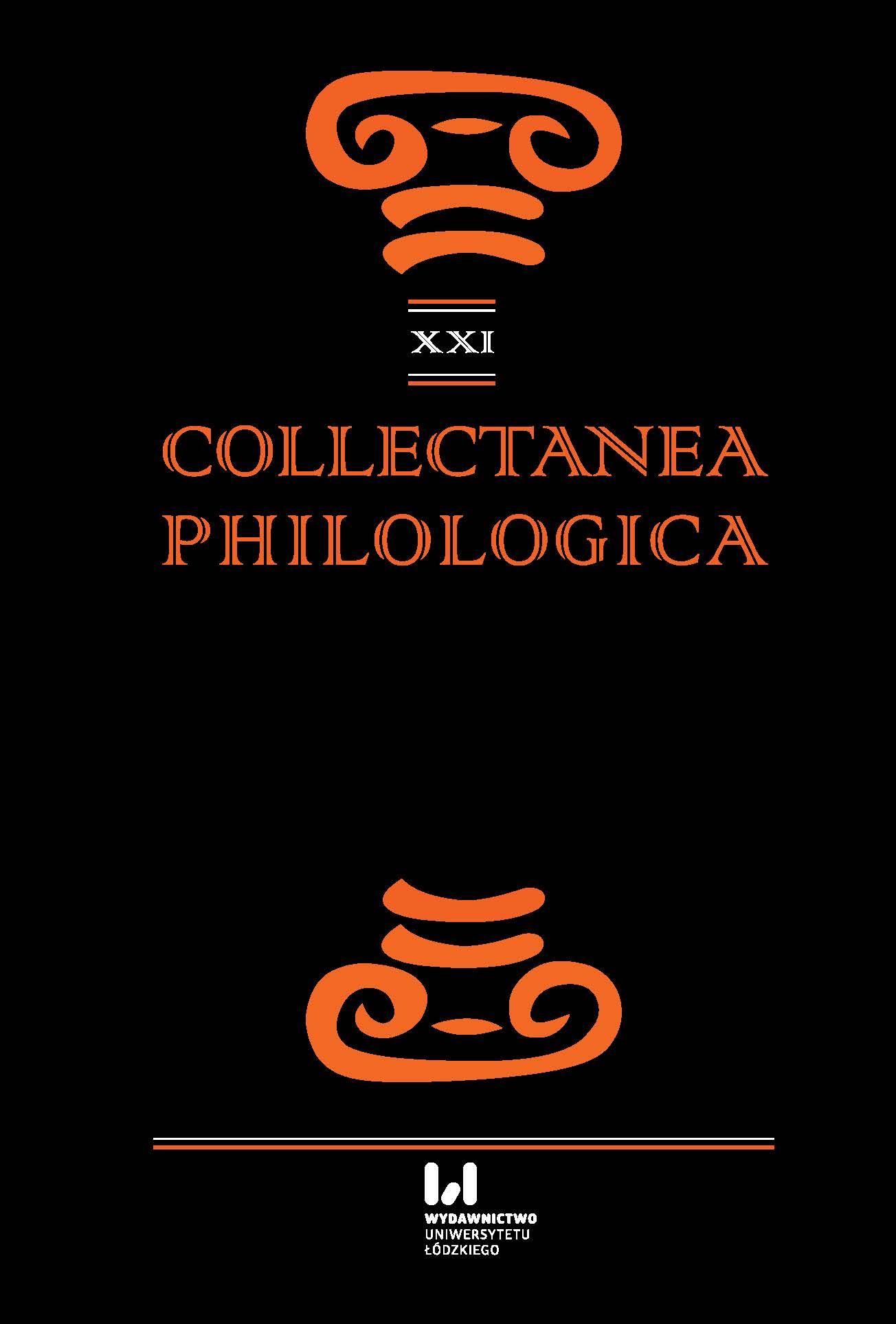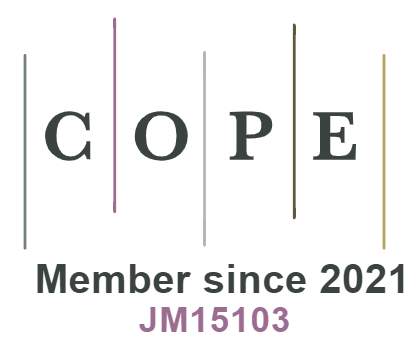Problem antycznej ekfrazy teatralnej. Część II: Scenografia
DOI:
https://doi.org/10.18778/1733-0319.21.04Słowa kluczowe:
ekfrasis, scenography, ancient Greek tragedy, EuripidesAbstrakt
One of the dramatic ekphrasis forms is the ekphrasis of stage design. It describes what is usually made visible, at least partially, to the public, drawing its attention to important elements of scenography that played a significant role in the performance. Therefore it was necessary to make the spectators aware of those elements. They were used by all three tragedians: Aeschylus, Sophocles and Euripides. The article focuses on selected ekphrases of scenography taken from three Euripidean tragedies: Iphigenia in Tauris, Ion, Alcestis, and on their role in the structure of drama.
Bibliografia
Arystoteles (1988). Poetyka, [w:] Arystoteles, Retoryka. Poetyka, przeł. i oprac. H. Podbielski. Warszawa: Państwowe Wydawnictwo Naukowe.
Google Scholar
Barnes H.E. (1968). „Greek Tragicomedy”, [w:] Twentieth century interpretations of Euripides’ Alcestis, J.R. Wilson (ed.). New Jersey: Prentice-Hall. 22–36.
Google Scholar
Cataudella, Q. (1976). „Lektura dello ‘Ione’ Euripideo”, [w:] Euripide. Letture critiche, a cura di O. di Longo. Milano: Mursia editore. 110–127.
Google Scholar
Chodkowski, R.R. (2007). „Na granicy obrazu scenicznego i słowa, czyli audioskrypcja supletywna w teatrze Sofoklesa”, [w:] From Antiquity to Modern Times Classical Poetry and Its Modern Reception. Essays in Honour of Stanisław Stabryła. Jerzy Styka (ed.). Kraków: Księgarnia Akademicka. 111–128.
Google Scholar
Conacher, D.J. (1967). Euripidean Drama. Myth, Theme and Structure. Toronto: University of Toronto Press.
Google Scholar
Czerwińska, J. (2004). „Fantastyka i baśniowość w ‘Alkestis’ Eurypidesa” (Le fantastique et le surnaturel dans ‘l’Alceste’ d’Euripide), [w:] Thaleia. Humor w antyku. G. Malinowski (ed.). „Classica Wratislaviensia” XXIV, 18–33.
Google Scholar
Czerwińska, J. (2005). „Eurypides i jego twórczość dramatyczna oraz mniejsi tragediopisarze”, [w:] Literatura Grecji starożytnej, t. I, Epika-Liryka-Dramat, pod red. H. Podbielskiego. Lublin: Towarzystwo Naukowe KUL. 771–876.
Google Scholar
Czerwińska, J. (2013). Innowacje mitologiczne i dramaturgiczne Eurypidesa. Tragedia. Tragikomedia. Łódź: Wydawnictwo Uniwersytetu Łódzkiego.
Google Scholar
Di Benedetto, V., Medda, E. (1997). La tragedia sulla scena. La tragedia greca in quanto spettacolo teatrale. Torino: Einaudi.
Google Scholar
Euripides (1937). Euripidis Fabulae, vol. 2, ed. G. Murray. Oxonii: Oxford University Press.
Google Scholar
Euripides (1947). Euripidis Fabulae, vol. 1, ed. G. Murray. Oxonii: Oxford University Press.
Google Scholar
Euripides (1978). Euripidis Fabulae, vol. 3, ed. G. Murray. Oxonii: Oxford University Press.
Google Scholar
Eurypides (1967). Tragedie, t. 1, przeł. i oprac. J. Łanowski. Warszawa: PIW.
Google Scholar
Eurypides (1972). Tragedie, t. 2, przeł. i oprac. J. Łanowski. Warszawa: PIW.
Google Scholar
Eurypides (1980). Tragedie, t. 3, przeł. i oprac. J. Łanowski. Warszawa: PIW.
Google Scholar
Filostrat Starszy (2004). Obrazy, przeł. R. Popowski. Warszawa: Prószyński i S-ka.
Google Scholar
Fritz, K. von (1968). „The Happy Ending of Alcestis”, [w:] Twentieth century interpretations of Euripides’ Alcestis, J.R. Wilson (ed.). New Jersey: Prentice-Hall. 80–84
Google Scholar
Grube, G.M.A. (1961). The Drama of Euripides. London: Barnes & Noble.
Google Scholar
Harder E.E. (1993). Die Frauenrollen bei Euripides. Untersuchungen zu Alkestis, Medea, Hekabe, Erechtheus, Elektra, Troades und Iphigeneia in Aulis. Stuttgart: M&P Verlag für Wissenschaft und Forschung.
Google Scholar
Lakoff, G., Johnson, M. (1988). Metafory w naszym życiu, przeł. i wstęp. opatrzył Tomasz P. Krzeszowski. Warszawa: Państwowy Instytut Wydawniczy.
Google Scholar
Lesky, A. (2006). Tragedia grecka, przeł. M. Weiner. Kraków: Homini.
Google Scholar
Longo, O. (1976). Euripide. Letture critiche. Milano: Mursia editore.
Google Scholar
Łanowski, J. (1967). Słowo wstępne, [w:] Eurypides, Tragedie. t. 1, przeł. i oprac. J. Łanowski. Warszawa: PIW.
Google Scholar
Matthiessen, K. (2004). Euripides und sein Jahrhundert. München: Verlag G.C. Beck.
Google Scholar
Murray, G. (1932). Euripidem e i suoi tempi, trad it. di N. Ruffini. Bari: Laterza.
Google Scholar
Pavis, P. (2002). Słownik terminów teatralnych, wstęp A. Ubersfeld, przekł. S. Świontek. Wrocław: Ossolineum.
Google Scholar
Philostrati maioris (1893). Imagines. O. Benndorf and K. Schenkl (ed.). Leipzig: Teubner.
Google Scholar
Popowski, R. (2004). „Starożytny przewodnik po neapolitańskiej pinakotece”, [w:] Filostrat Starszy, Obrazy, przeł. R. Popowski. Warszawa: Prószyński i S-ka. 13–87.
Google Scholar
Rosenmeyer, T.G. (1968). „The Chorus and Admetus”, [w:] Twentieth century interpretations of Euripides’ Alcestis, J.R. Wilson (ed.). New Jersey: Prentice-Hall. 65–70.
Google Scholar
Smith, W.D. (1968). „The ironic structure in Alcestis”, [w:] Twentieth century interpretations of Euripides’ Alcestis, J.R. Wilson (ed.). New Jersey: Prentice-Hall. 37–56.
Google Scholar
Pobrania
Opublikowane
Jak cytować
Numer
Dział
Licencja

Utwór dostępny jest na licencji Creative Commons Uznanie autorstwa – Użycie niekomercyjne – Bez utworów zależnych 4.0 Międzynarodowe.












